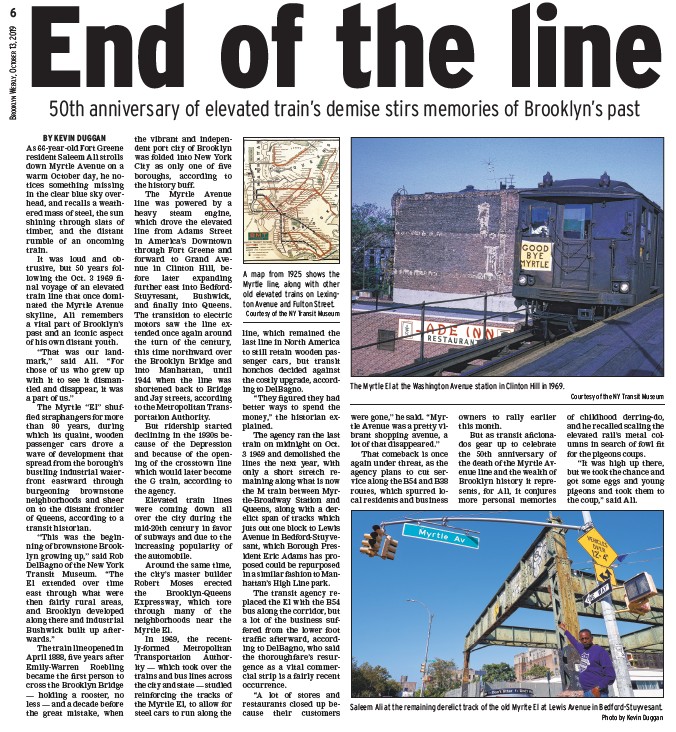
6
BROOKLYN WEEKLY, OCTOBER 13, 2019
End of the line 50th anniversary of elevated train’s demise stirs memories of Brooklyn’s past
BY KEVIN DUGGAN
As 66-year-old Fort Greene
resident Saleem Ali strolls
down Myrtle Avenue on a
warm October day, he notices
something missing
in the clear blue sky overhead,
and recalls a weathered
mass of steel, the sun
shining through slats of
timber, and the distant
rumble of an oncoming
train.
It was loud and obtrusive,
but 50 years following
the Oct. 3 1969 fi -
nal voyage of an elevated
train line that once dominated
the Myrtle Avenue
skyline, Ali remembers
a vital part of Brooklyn’s
past and an iconic aspect
of his own distant youth.
“That was our landmark,”
said Ali. “For
those of us who grew up
with it to see it dismantled
and disappear, it was
a part of us.”
The Myrtle “El” shuffl
ed straphangers for more
than 80 years, during
which its quaint, wooden
passenger cars drove a
wave of development that
spread from the borough’s
bustling industrial waterfront
eastward through
burgeoning brownstone
neighborhoods and sheer
on to the distant frontier
of Queens, according to a
transit historian.
“This was the beginning
of brownstone Brooklyn
growing up,” said Rob
DelBagno of the New York
Transit Museum. “The
El extended over time
east through what were
then fairly rural areas,
and Brooklyn developed
along there and industrial
Bushwick built up afterwards.”
The train line opened in
April 1888, fi ve years after
Emily-Warren Roebling
became the fi rst person to
cross the Brooklyn Bridge
— holding a rooster, no
less — and a decade before
the great mistake, when
the vibrant and independent
port city of Brooklyn
was folded into New York
City as only one of fi ve
boroughs, according to
the history buff.
The Myrtle Avenue
line was powered by a
heavy steam engine,
which drove the elevated
line from Adams Street
in America’s Downtown
through Fort Greene and
forward to Grand Avenue
in Clinton Hill, before
later expanding
further east into Bedford-
Stuyvesant, Bushwick,
and fi nally into Queens.
The transition to electric
motors saw the line extended
once again around
the turn of the century,
this time northward over
the Brooklyn Bridge and
into Manhattan, until
1944 when the line was
shortened back to Bridge
and Jay streets, according
to the Metropolitan Transportation
Authority.
But ridership started
declining in the 1930s because
of the Depression
and because of the opening
of the crosstown line
which would later become
the G train, according to
the agency.
Elevated train lines
were coming down all
over the city during the
mid-20th century in favor
of subways and due to the
increasing popularity of
the automobile.
Around the same time,
the city’s master builder
Robert Moses erected
the Brooklyn-Queens
Expressway, which tore
through many of the
neighborhoods near the
Myrtle El.
In 1969, the recently
formed Metropolitan
Transportation Authority
— which took over the
trains and bus lines across
the city and state — studied
reinforcing the tracks of
the Myrtle El, to allow for
steel cars to run along the
line, which remained the
last line in North America
to still retain wooden passenger
cars, but transit
honchos decided against
the costly upgrade, according
to DelBagno.
“They fi gured they had
better ways to spend the
money,” the historian explained.
The agency ran the last
train on midnight on Oct.
3 1969 and demolished the
lines the next year, with
only a short stretch remaining
along what is now
the M train between Myrtle
Broadway Station and
Queens, along with a derelict
span of tracks which
juts out one block to Lewis
Avenue in Bedford-Stuyvesant,
which Borough President
Eric Adams has proposed
could be repurposed
in a similar fashion to Manhattan’s
High Line park .
The transit agency replaced
the El with the B54
bus along the corridor, but
a lot of the business suffered
from the lower foot
traffi c afterward, according
to DelBagno, who said
the thoroughfare’s resurgence
as a vital commercial
strip is a fairly recent
occurrence.
“A lot of stores and
restaurants closed up because
their customers
The Myrtle El at the Washington Avenue station in Clinton Hill in 1969.
Courtesy of the NY Transit Museum
were gone,” he said. “Myrtle
Avenue was a pretty vibrant
shopping avenue, a
lot of that disappeared.”
That comeback is once
again under threat, as the
agency plans to cut service
along the B54 and B38
routes, which spurred local
residents and business
owners to rally earlier
this month.
But as transit afi cionados
gear up to celebrate
the 50th anniversary of
the death of the Myrtle Avenue
line and the wealth of
Brooklyn history it represents,
for Ali, it conjures
more personal memories
of childhood derring-do,
and he recalled scaling the
elevated rail’s metal columns
in search of fowl fi t
for the pigeons coups.
“It was high up there,
but we took the chance and
got some eggs and young
pigeons and took them to
the coup,” said Ali.
A map from 1925 shows the
Myrtle line, along with other
old elevated trains on Lexington
Avenue and Fulton Street.
Courtesy of the NY Transit Museum
Saleem Ali at the remaining derelict track of the old Myrlte El at Lewis Avenue in Bedford-Stuyvesant.
Photo by Kevin Duggan